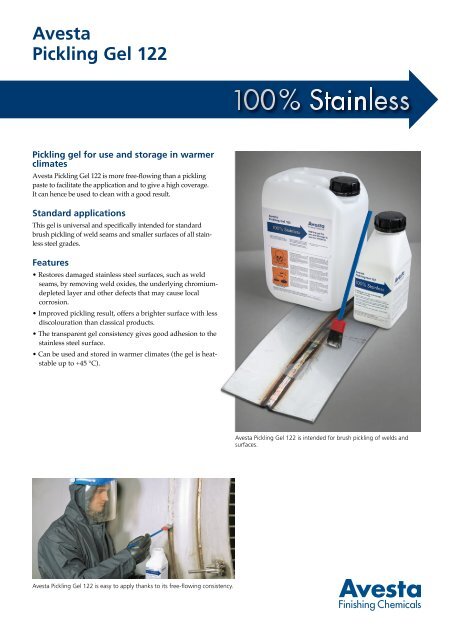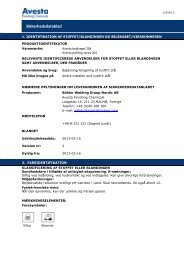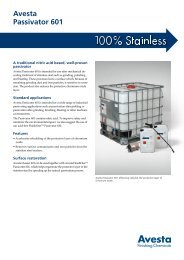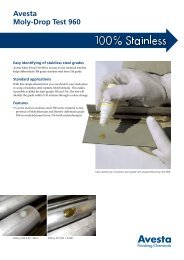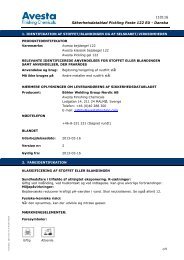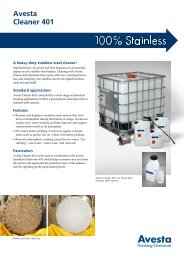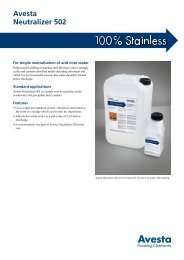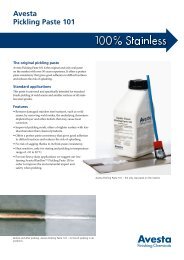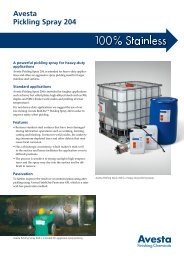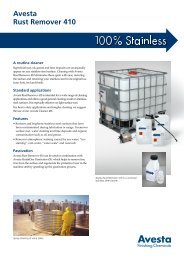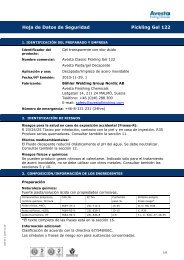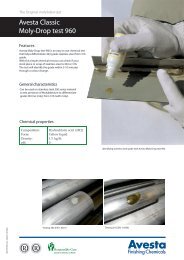Avesta Pickling Gel 122
Avesta Pickling Gel 122 - Avesta Finishing Chemicals
Avesta Pickling Gel 122 - Avesta Finishing Chemicals
- No tags were found...
You also want an ePaper? Increase the reach of your titles
YUMPU automatically turns print PDFs into web optimized ePapers that Google loves.
<strong>Avesta</strong><br />
<strong>Pickling</strong> <strong>Gel</strong> <strong>122</strong><br />
<strong>Pickling</strong> gel for use and storage in warmer<br />
climates<br />
<strong>Avesta</strong> <strong>Pickling</strong> <strong>Gel</strong> <strong>122</strong> is more free-flowing than a pickling<br />
paste to facilitate the application and to give a high coverage.<br />
It can hence be used to clean with a good result.<br />
Standard applications<br />
This gel is universal and specifically intended for standard<br />
brush pickling of weld seams and smaller surfaces of all stainless<br />
steel grades.<br />
Features<br />
• Restores damaged stainless steel surfaces, such as weld<br />
seams, by removing weld oxides, the underlying chromiumdepleted<br />
layer and other defects that may cause local<br />
corrosion.<br />
• Improved pickling result, offers a brighter surface with less<br />
discolouration than classical products.<br />
• The transparent gel consistency gives good adhesion to the<br />
stainless steel surface.<br />
• Can be used and stored in warmer climates (the gel is heatstable<br />
up to +45 °C).<br />
<strong>Avesta</strong> <strong>Pickling</strong> <strong>Gel</strong> <strong>122</strong> is intended for brush pickling of welds and<br />
surfaces.<br />
<strong>Avesta</strong> <strong>Pickling</strong> <strong>Gel</strong> <strong>122</strong> is easy to apply thanks to its free-flowing consistency.
Instructions for use<br />
1. 2. 3. 4.<br />
1. Stir or shake the paste before use.<br />
2. Apply the paste with an acid-resistant<br />
brush.<br />
3. Leave the paste to work 30 min to 4 hours<br />
(depending on temperature and steel<br />
grade). The temperature of the workpiece<br />
should always be higher than +5 °C.<br />
4. Remove pickling residues by using a<br />
high-pressure water jet, or with a stainless<br />
steel brush and then rinse with water.<br />
The waste water should be treated before<br />
discharge.<br />
Packaging<br />
<strong>Avesta</strong> <strong>Pickling</strong> <strong>Gel</strong> <strong>122</strong> is supplied in a 2.4 kg polyethylene<br />
container supplied in a 4-pack cardboard box, and a 12 kg<br />
polyethylene container.<br />
All packing material follows the UN regulations for Hazardous<br />
goods.<br />
Storage<br />
<strong>Avesta</strong> <strong>Pickling</strong> <strong>Gel</strong> <strong>122</strong> should be stored indoors at room<br />
temperature. Containers must be kept properly closed, in an<br />
upright position and inaccessible to unauthorised persons.<br />
The product is perishable and should not be kept in storage<br />
longer than necessary. It has a maximum shelf life of two<br />
years when stored at room temperature. Exposure to higher<br />
temperatures (> 45 °C) may damage the product and reduce<br />
the shelf life.<br />
Worker safety<br />
<strong>Avesta</strong> First Aid Spray 910 should be readily accessible to<br />
all those who work with pickling. It comes in a handy 200 ml<br />
spray can and the content has been optimised to decontaminate<br />
small acid-splashes of pickling paste.<br />
Protective clothing. In general users should wear acidresistant<br />
overalls, gloves and rubber boots. Face visor should<br />
be used and, if necessary, suitable respiratory protective<br />
devices.<br />
Good Chemistry at Work<br />
Special conditions may apply from one country to another.<br />
Consult our website where updated Safety Data Sheets can<br />
be found.<br />
Waste treatment<br />
The waste water produced when pickling contains acids<br />
and should be treated with <strong>Avesta</strong> Neutraliser 502 or with<br />
slaked lime to a pH-value of 7–10 before discharge.<br />
Heavy metals from the stainless steel are precipitated as a<br />
sludge, and should be sent for deposition according to local<br />
regulations.<br />
Empty containers (HDPE) must be cleaned and can then be<br />
recycled according to local regulations.<br />
Other information<br />
For more information, please visit our website<br />
www.avestafinishing.com where you can find Safety<br />
Data Sheets and other useful information.<br />
Böhler Welding Group Nordic AB<br />
<strong>Avesta</strong> Finishing Chemicals<br />
Lodgatan 14<br />
SE-211 24 Malmö, Sweden<br />
Tel: +46 (0)40 28 83 00<br />
Fax: +46 (0)40 93 94 24<br />
www.avestafinishing.com<br />
I10260-1EN ver 1, 2012.03 Wahlgren & Hansson<br />
Information given in this brochure may be subject to alteration without notice. Care has been taken to ensure that the contents of this publication are accurate, but Böhler Welding Group<br />
Nordic AB and its subsidiary companies do not accept responsibility for errors or for information which is found to be misleading. Suggestions for or descriptions of the end use or application<br />
of products or methods of working are for information only and the company and its subsidiaries accept no liability in respect thereof. Before using products supplied or manufactured by the<br />
company the customer should satisfy himself of their suitability.


